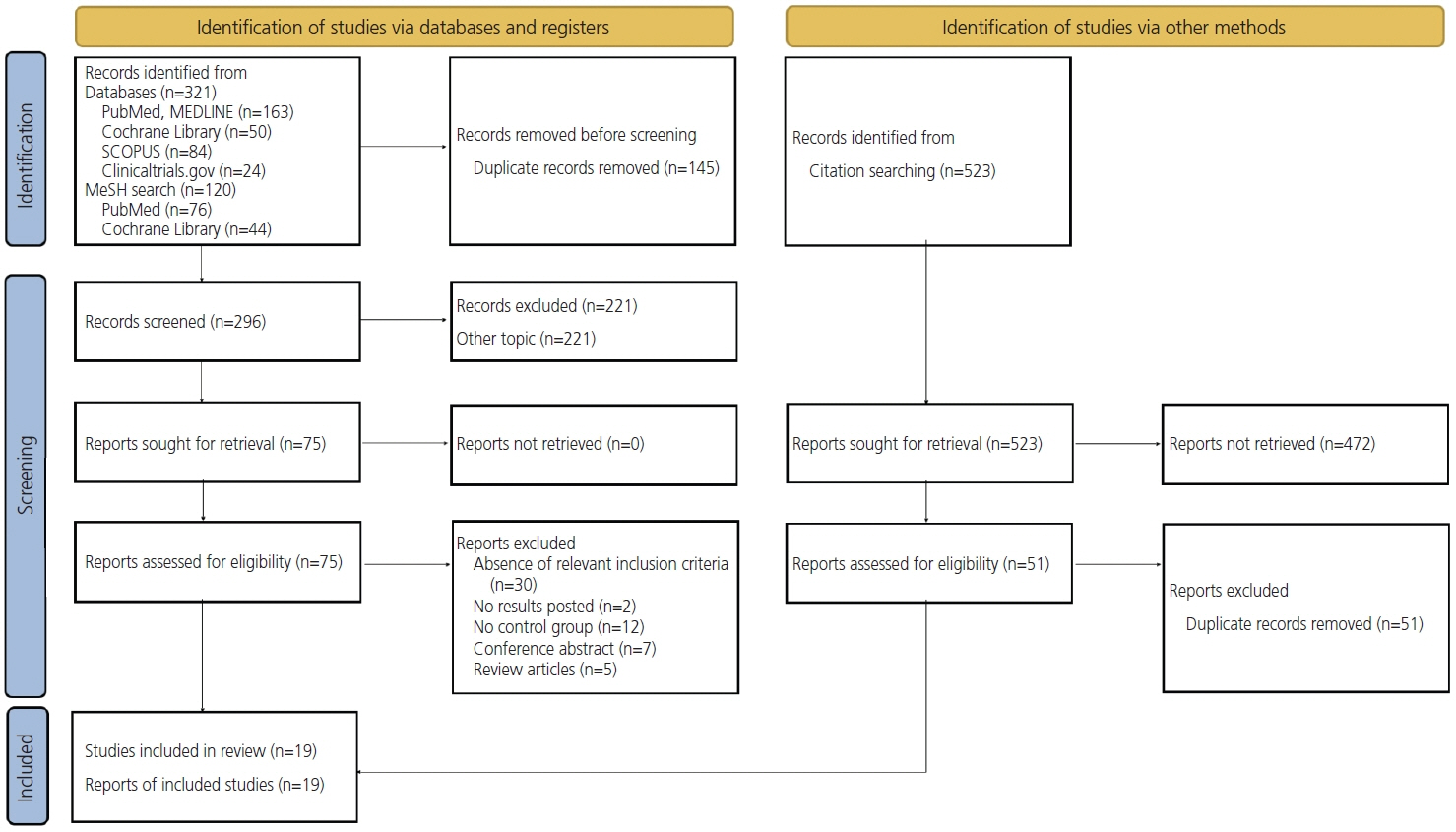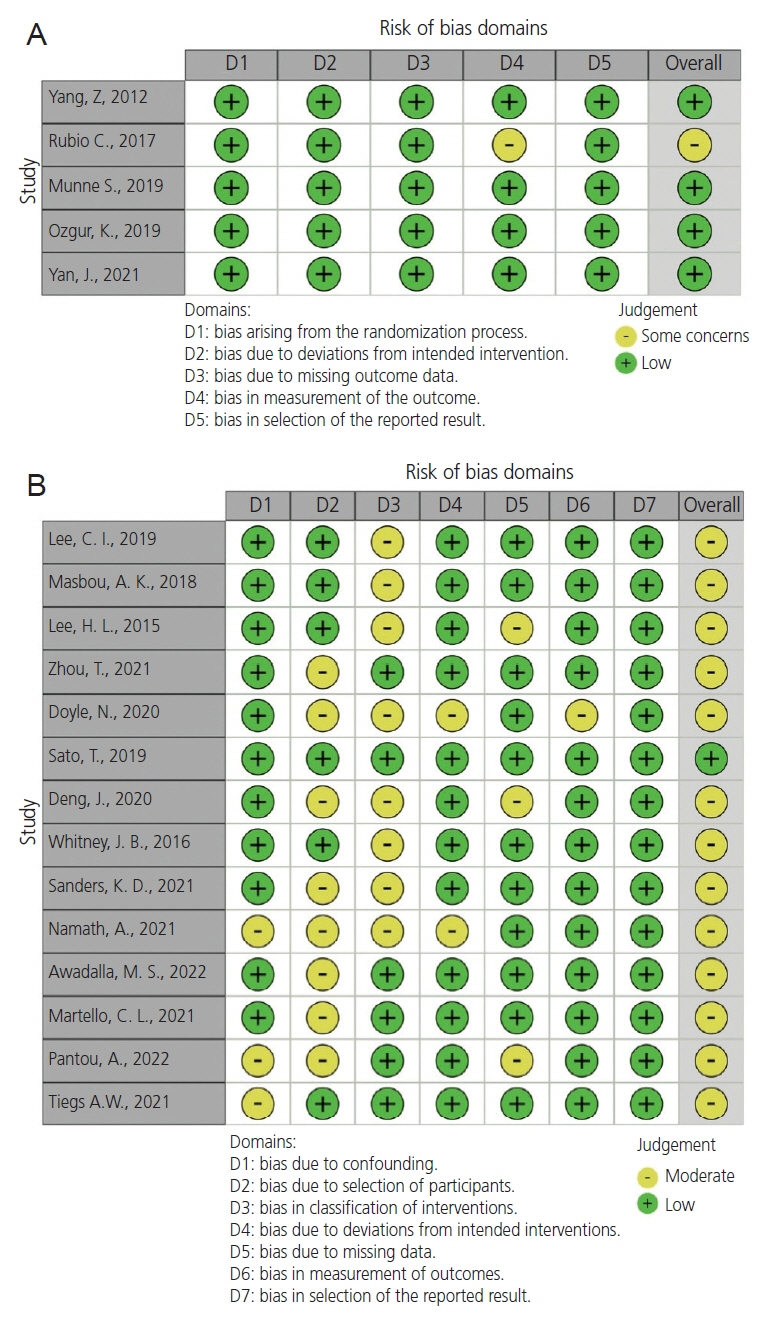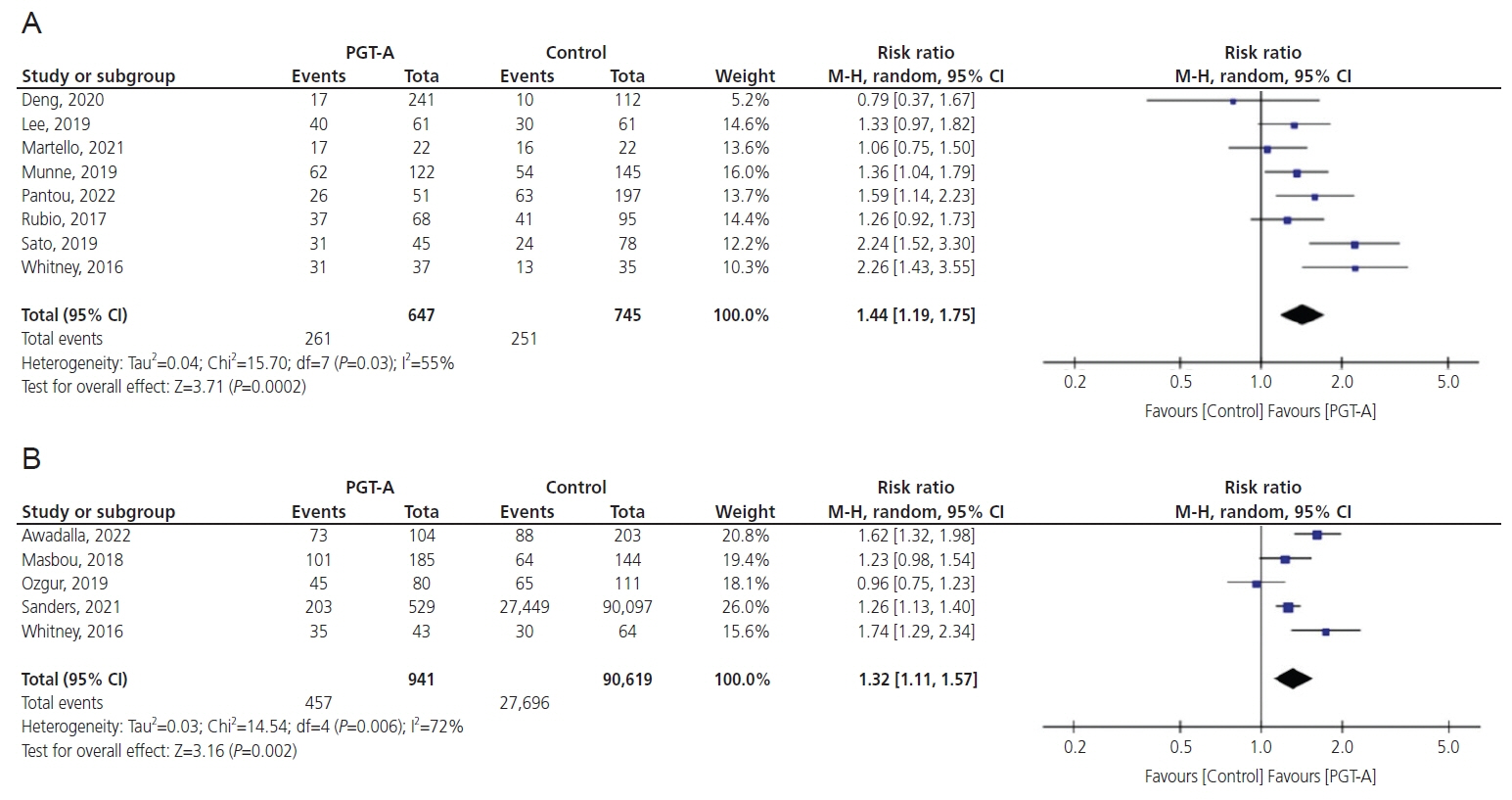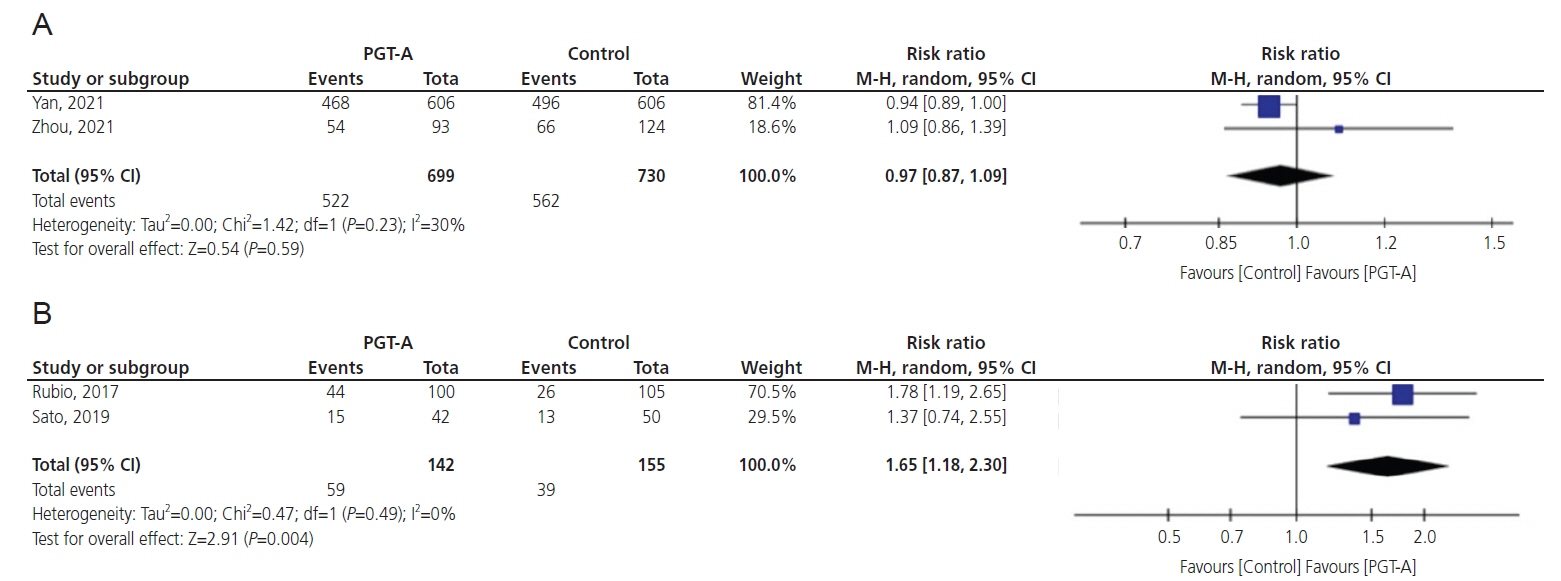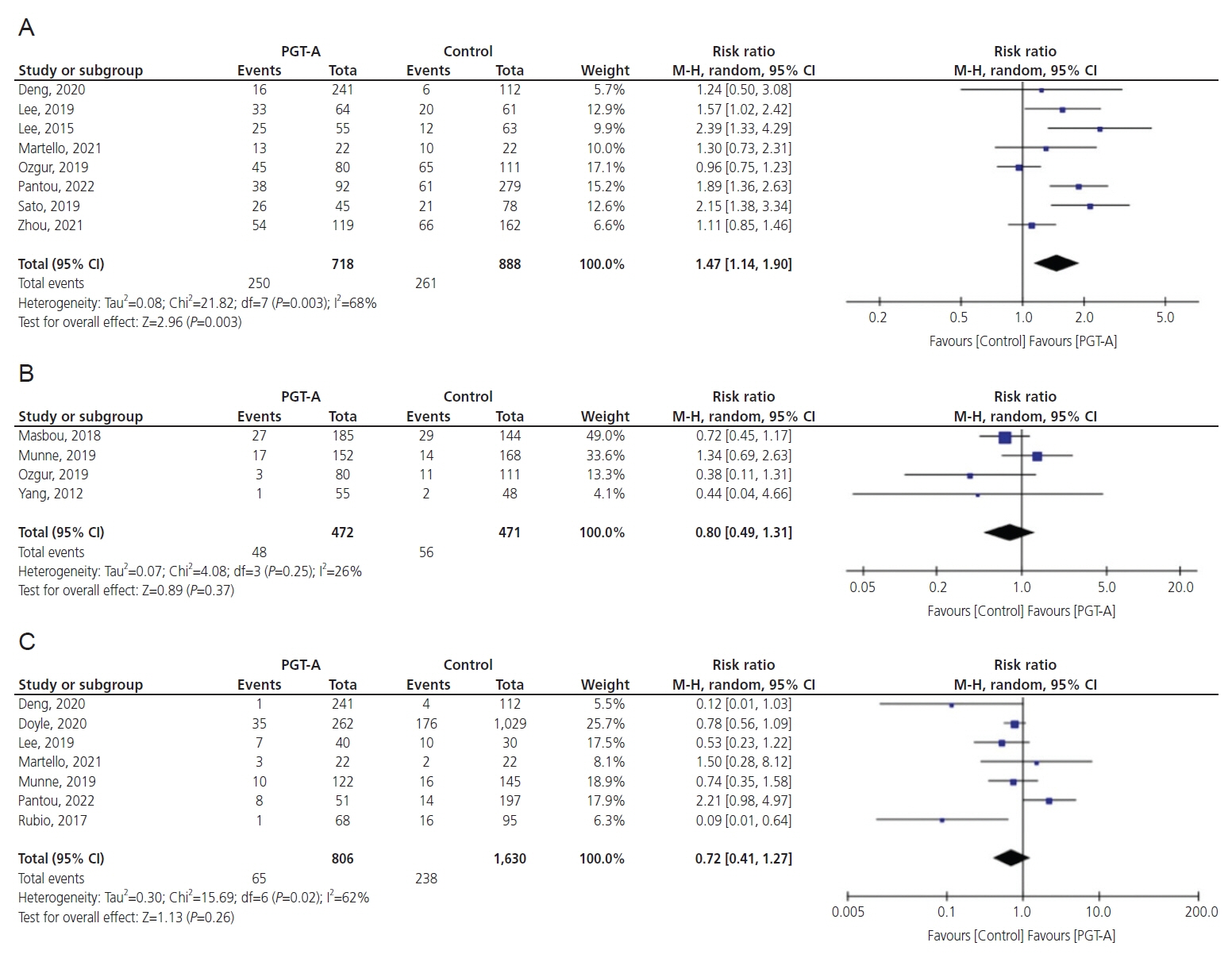Obstet Gynecol Sci.
2024 Jul;67(4):356-379. 10.5468/ogs.24028.
Preimplantation genetic testing for aneuploidy in patients of different age: a systematic review and meta-analysis
- Affiliations
-
- 1Department of Operative Gynecology, Research Center for Obstetrics, Gynecology and Perinatology, Moscow, Russia
- 2Department of Reproductive Medicine and Surgery, Moscow State University of Medicine and Dentistry, Moscow, Russia
- 3Department of Operative Gynecology, First Moscow State Medical University, Moscow, Russia
- KMID: 2557854
- DOI: http://doi.org/10.5468/ogs.24028
Abstract
- This study aimed to summarize the current knowledge on the benefits of in vitro fertilization/intracytoplasmic sperm injection with preimplantation genetic testing for aneuploidy (PGT-A) and to discuss the role of PGT-A in patients of different ages undergoing assisted reproduction. A systematic review was conducted in accordance with the Preferred Reporting Items for Systematic Reviews and Meta-Analyses 2020 checklist. Registration number: CRD42022354697. Studies were identified by searching the PubMed, Cochrane Library, Google Scholar, Scopus, Embase, and ClinicalTrials databases. Seven meta-analyses were performed with additional stratification of age and prognosis of the women studied. Clinical pregnancy rate per embryo transfer in patients aged >35 years was higher in the PGT-A group (P=0.0002) than in controls. Live birth rate (LBR) per embryo transfer in women 35 years old or younger (P=0.002) was higher in the PGT-A group. The LBR per patient in women aged >35 years was higher in the PGT-A group (P=0.004). The effects of PGT-A on LBR in patients with poor prognosis showed a statistically significant increase (P=0.003). There was no significant difference in the rate between the two groups. PGT-A is effective and can be recommended for patients aged >35 years undergoing assisted reproduction to improve their reproductive outcomes. Moreover, our study showed the possible benefits of PGT-A in patients with a poor prognosis. Overall, our findings suggest that PGT-A is a valuable tool for improving the reproductive outcomes of assisted reproductive procedures in older women and those with a history of pregnancy complications.
Keyword
Figure
Reference
-
References
1. Heijnen EM, Macklon NS, Fauser BC. What is the most relevant standard of success in assisted reproduction? The next step to improving outcomes of IVF: consider the whole treatment. Hum Reprod. 2004; 19:1936–8.2. Franasiak JM, Forman EJ, Hong KH, Werner MD, Upham KM, Treff NR, et al. The nature of aneuploidy with increasing age of the female partner: a review of 15,169 consecutive trophectoderm biopsies evaluated with comprehensive chromosomal screening. Fertil Steril. 2014; 101:656–63.e1.
Article3. Zegers-Hochschild F, Adamson GD, Dyer S, Racowsky C, de Mouzon J, Sokol R, et al. The International glossary on infertility and fertility care, 2017. Fertil Steril. 2017; 108:393–406.
Article4. Fragouli E, Alfarawati S, Daphnis DD, Goodall NN, Mania A, Griffiths T, et al. Cytogenetic analysis of human blastocysts with the use of FISH, CGH and aCGH: scientific data and technical evaluation. Hum Reprod. 2011; 26:480–90.5. Pirtea P, De Ziegler D, Tao X, Sun L, Zhan Y, Ayoubi JM, et al. Rate of true recurrent implantation failure is low: results of three successive frozen euploid single embryo transfers. Fertil Steril. 2021; 115:45–53.
Article6. Goossens V, Harton G, Moutou C, Traeger-Synodinos J, Van Rij M, Harper JC. ESHRE PGD consortium data collection IX: cycles from January to December 2006 with pregnancy follow-up to October 2007. Hum Reprod. 2009; 24:1786–810.
Article7. Twisk M, Mastenbroek S, van Wely M, Heineman MJ, Van der Veen F, Repping S. Preimplantation genetic screening for abnormal number of chromosomes (aneuploidies) in in vitro fertilisation or intracytoplasmic sperm injection. Cochrane Database Syst Rev. 2006; (1):CD005291.
Article8. Page MJ, McKenzie JE, Bossuyt PM, Boutron I, Hoffmann TC, Mulrow CD, et al. The PRISMA 2020 statement: an updated guideline for reporting systematic reviews. Syst Rev. 2021; 10:89.9. Coonen E, Rubio C, Christopikou D, Dimitriadou E, Gontar J, Goossens V, et al. ESHRE PGT consortium good practice recommendations for the detection of structural and numerical chromosomal aberrations. Hum Reprod Open. 2020; 2020:hoaa017.10. Higgins JPT, Thomas J, Chandler J, Cumpston M, Li T, Page MJ, et al. Cochrane Handbook for Systematic Reviews of Interventions version 6.1 [Internet]. Chichester: John Wiley & Sons; c2019 [cited 2021 Jan 4]. Available from: https://training.cochrane.org/handbook/archive/v6.1.11. Sterne JAC, Savović J, Page MJ, Elbers RG, Blencowe NS, Boutron I, et al. RoB 2: a revised tool for assessing risk of bias in randomised trials. BMJ . 2019; 366:l4898.
Article12. Sterne JA, Hernán MA, Reeves BC, Savović J, Berkman ND, Viswanathan M, et al. ROBINS-I: a tool for assessing risk of bias in non-randomised studies of interventions. BMJ. 2016; 355:i4919.
Article13. Mantravadi K, Mathew S, Soorve S, Rao DG, Karunakaran S. Does pre-implantation genetic testing for aneuploidy optimise the reproductive outcomes in-women with idiopathic recurrent pregnancy loss? Fertil Steril. 2020; 114:e437.
Article14. McCulloh DH, Grifo JA. Preimplantation genetic testing (pgt) success in the united states (2014-2017): multiple outcome measures indicate superiority of pgt over no pgt. Fertil Steril. 2020; 114:e413. –4.
Article15. Aharon D, Gounko D, Lee JA, Mukherjee T, Copperman AB, Sekhon L. Preimplantation genetic testing for aneuploidy in donor oocyte ivf cycles: a matched, sibling oocyte cohort study. Fertil Steril. 2020; 114:e275.16. Munné S, Kaplan B, Frattarelli JL, Gysler M, Child T, Nakhuda G, et al. Preimplantation genetic testing for aneuploidy: a pragmatic, multicenter randomized clinical trial of single frozen euploid embryo transfer versus selection by morphology alone. Reprod Biomed Onlin. 2019; 38:e9.
Article17. Yang Z, Kuang Y, Meng Y, Zhang X, Su L, Lyu Q, et al. Selecting single euploid blastocysts for transfer with NGS significantly improves IVF treatment outcomes: a randomized study. Reprod Biomed Online. 2019; 38:e20. –1.
Article18. Canon CM, Aharon D, Gounko D, Lee JA, Roth RM, Slifkin R, et al. Should patients with only two embryos eligbile for biopsy after a single controlled ovarian hyperstimulation cycle utilize pgt-a prior to transfer selection? Cycles without PGT-A. Fertil Steril. 2021; 116:e246.
Article19. Daneshmand S, Richter KS, Gu R, Miller D, Tober D, Lin MP, et al. Value of preimplantation genetic testing for aneuploidy (pgt-a) in the context of in vitro fertilization (ivf) using donor oocytes. Fertil Steril. 2021; 116:e401.
Article20. Scott RT Jr, Upham KM, Forman EJ, Hong KH, Scott KL, Taylor D, et al. Blastocyst biopsy with comprehensive chromosome screening and fresh embryo transfer significantly increases in vitro fertilization implantation and delivery rates: a randomized controlled trial. Fertil Steril. 2013; 100:697–703.21. Comparison of the live birth rate of PGT versus expectant management in patients with RPL [Internet]. Shanghai: Shanghai First Maternity and Infant Hospital; c2022 [cited 2022 Jul 14]. Available from: https://clinicaltrials.gov/study/NCT05457335.22. Sui YL, Lei CX, Ye JF, Fu J, Zhang S, Li L, et al. In vitro fertilization with single-nucleotide polymorphism microarray-based preimplantation genetic testing for aneuploidy significantly improves clinical outcomes in infertile women with recurrent pregnancy loss: a randomized controlled trial. Reprod Dev Med. 2020; 4:32–41.
Article23. Haviland MJ, Murphy LA, Modest AM, Fox MP, Wise LA, Nillni YI, et al. Comparison of pregnancy outcomes following preimplantation genetic testing for aneuploidy using a matched propensity score design. Hum Reprod. 2020; 35:2356–64.
Article24. Sacchi L, Albani E, Cesana A, Smeraldi A, Parini V, Fabiani M, et al. Preimplantation genetic testing for aneuploidy improves clinical, gestational, and neonatal outcomes in advanced maternal age patients without compromising cumulative live-birth rate. J Assist Reprod Genet. 2019; 36:2493–504.
Article25. Roeca C, Johnson R, Carlson N, Polotsky AJ. Preimplantation genetic testing and chances of a healthy live birth amongst recipients of fresh donor oocytes in the United States. J Assist Reprod Genet. 2020; 37:2283–92.
Article26. Ying LY, Sanchez MD, Baron J, Ying Y. Preimplantation genetic testing and frozen embryo transfer synergistically decrease very pre-term birth in patients undergoing in vitro fertilization with elective single embryo transfer. J Assist Reprod Genet. 2021; 38:2333–39.27. Bhatt SJ, Marchetto NM, Roy J, Morelli SS, McGovern PG. Pregnancy outcomes following in vitro fertilization frozen embryo transfer (IVF-FET) with or without preimplantation genetic testing for aneuploidy (PGT-A) in women with recurrent pregnancy loss (RPL): a SARTCORS study. Hum Reprod . 2021; 35:2339–44.
Article28. Murphy LA, Seidler EA, Vaughan DA, Resetkova N, Penzias AS, Toth TL, et al. To test or not to test? A framework for counselling patients on preimplantation genetic testing for aneuploidy (PGT-A). Hum Reprod. 2019; 34:268–75.
Article29. Kushnir VA, Darmon SK, Albertini DF, Barad DH, Gleicher N. Effectiveness of in vitro fertilization with preimplantation genetic screening: a reanalysis of United States assisted reproductive technology data 2011-2012. Fertil Steril. 2016; 106:75–9.30. Sarkar P, Jindal S, New EP, Sprague RG, Tanner J, Imudia AN. The role of preimplantation genetic testing for aneuploidy in a good prognosis IVF population across different age groups. Syst Biol Reprod Med. 2021; 67:366–73.
Article31. Mastenbroek S, Twisk M, van Echten-Arends J, Sikkema-Raddatz B, Korevaar JC, Verhoeve HR, et al. In vitro fertilization with preimplantation genetic screening. N Engl J Med. 2007; 357:9–17.32. Mejia RB, Capper EA, Summers KM, Mancuso AC, Sparks AE, Van Voorhis BJ. Cumulative live birth rate in women aged ≤37 years after in vitro fertilization with or without preimplantation genetic testing for aneuploidy: a Society for Assisted Reproductive Technology clinic outcome reporting system retrospective analysis. F S Rep. 2022; 3:184–91.33. Gianaroli L, Magli MC, Munné S, Fiorentino A, Montanaro N, Ferraretti AP. Will preimplantation genetic diagnosis assist patients with a poor prognosis to achieve pregnancy? Hum Reprod. 1997; 12:1762–7.
Article34. Staessen C, Platteau P, Van Assche E, Michiels A, Tournaye H, Camus M, et al. Comparison of blastocyst transfer with or without preimplantation genetic diagnosis for aneuploidy screening in couples with advanced maternal age: a prospective randomized controlled trial. Hum Reprod. 2004; 19:2849–58.
Article35. Dang TT, Phung TM, Le H, Nguyen TB, Nguyen TS, Nguyen TL, et al. Preimplantation genetic testing of aneuploidy by next generation sequencing: association of maternal age and chromosomal abnormalities of blastocyst. Open Access Maced J Med Sci. 2019; 7:4427–31.
Article36. Hardarson T, Hanson C, Lundin K, Hillensjö T, Nilsson L, Stevic J, et al. Preimplantation genetic screening in women of advanced maternal age caused a decrease in clinical pregnancy rate: a randomized controlled trial. Hum Reprod. 2008; 23:2806–12.37. Staessen C, Verpoest W, Donoso P, Haentjens P, Van der Elst J, Liebaers I, et al. Preimplantation genetic screening does not improve delivery rate in women under the age of 36 following single-embryo transfer. Hum Reprod. 2008; 23:2818–25.
Article38. Ikuma S, Sato T, Sugiura-Ogasawara M, Nagayoshi M, Tanaka A, Takeda S. Preimplantation genetic diagnosis and natural conception: a comparison of live birth rates in patients with recurrent pregnancy loss associated with translocation. PLoS One . 2015; 10:e0129958.
Article39. Werlin L, Rodi I, DeCherney A, Marello E, Hill D, Munné S. Preimplantation genetic diagnosis as both a therapeutic and diagnostic tool in assisted reproductive technology. Fertil Steril. 2003; 80:467–8.40. Mersereau JE, Pergament E, Zhang X, Milad MP. Preimplantation genetic screening to improve in vitro fertilization pregnancy rates: a prospective randomized controlled trial. Fertil Steril. 2008; 90:1287–9.41. Meyer LR, Klipstein S, Hazlett WD, Nasta T, Mangan P, Karande VC. A prospective randomized controlled trial of preimplantation genetic screening in the “good prognosis” patient. Fertil Steril. 2009; 91:1731–8.42. Schoolcraft WB, Katz-Jaffe MG, Stevens J, Rawlins M, Munne S. Preimplantation aneuploidy testing for infertile patients of advanced maternal age: a randomized prospective trial. Fertil Steril. 2009; 92:157–62.43. Debrock S, Melotte C, Spiessens C, Peeraer K, Vanneste E, Meeuwis L, et al. Preimplantation genetic screening for aneuploidy of embryos after in vitro fertilization in women aged at least 35 years: a prospective randomized trial. Fertil Steril. 2010; 93:364–73.
Article44. Rubio C, Bellver J, Rodrigo L, Bosch E, Mercader A, Vidal C, et al. Preimplantation genetic screening using fluorescence in situ hybridization in patients with repetitive implantation failure and advanced maternal age: two randomized trials. Fertil Steril. 2013; 99:1400–7.45. Gianaroli L, Magli MC, Ferraretti AP, Munné S. Preimplantation diagnosis for aneuploidies in patients undergoing in vitro fertilization with a poor prognosis: identification of the categories for which it should be proposed. Fertil Steril. 1999; 72:837–44.
Article46. Blockeel C, Schutyser V, De Vos A, Verpoest W, De Vos M, Staessen C, et al. Prospectively randomized controlled trial of PGS in IVF/ICSI patients with poor implantation. Reprod Biomed Online. 2008; 17:848–54.47. Preimplantation genetic testing for aneuploidy (PGT-A) in women over 36 years of age [Internet]. Margate: Genomic Prediction Inc.; c2020 [cited 2023 Nov 18]. Available from: https://clinicaltrials.gov/show/NCT04167748.48. Mahesan AM, Chang PT, Ronn R, Paul ABM, Meriano J, Casper RF. Preimplantation genetic testing for aneuploidy in patients with low embryo numbers: benefit or harm? J Assist Reprod Genet. 2022; 39:2027–33.
Article49. Sadecki E, Rust L, Walker DL, Fredrickson JR, Krenik A, Kim T, et al. Comparison of live birth rates after IVF-embryo transfer with and without preimplantation genetic testing for aneuploidies. Reprod Biomed Online. 2021; 43:995–1001.
Article50. Preimplantation genetic diagnosis for the indication of advanced reproductive age [Internet]. Bethesda: ClinicalTrials.gov.; c2010 [cited 2022 Nov 4]. Available from: https://clinicaltrials.gov/ct2/show/NCT00646893.51. Preimplantation genetic diagnosis for the indication of advanced reproductive age [Internet]. Beverly Hills: Reprogenetics; c2010 [cited 2017 Jul 11]. Available from: https://clinicaltrials.gov/ct2/show/NCT00646893.52. Mazzilli R, Cimadomo D, Vaiarelli A, Capalbo A, Dovere L, Alviggi E, et al. Effect of the male factor on the clinical outcome of intracytoplasmic sperm injection combined with preimplantation aneuploidy testing: observational longitudinal cohort study of 1,219 consecutive cycles. Fertil Steril. 2017; 108:961–72.e3.
Article53. Del Carmen Nogales M, Cruz M, de Frutos S, Martínez EM, Gaytán M, Ariza M, et al. Association between clinical and IVF laboratory parameters and miscarriage after single euploid embryo transfers. Reprod Biol Endocrinol. 2021; 19:186.
Article54. Gorodeckaja J, Neumann S, McCollin A, Ottolini CS, Wang J, Ahuja K, et al. High implantation and clinical pregnancy rates with single vitrified-warmed blastocyst transfer and optional aneuploidy testing for all patients. Hum Fertil (Camb). 2020; 23:256–67.55. Viñals Gonzalez X, Odia R, Naja R, Serhal P, Saab W, Seshadri S, et al. Euploid blastocysts implant irrespective of their morphology after NGS-(PGT-A) testing in advanced maternal age patients. J Assist Reprod Genet. 2019; 36:1623–9.
Article56. Zhao H, Tao W, Li M, Liu H, Wu K, Ma S. Comparison of two protocols of blastocyst biopsy submitted to preimplantation genetic testing for aneuploidies: a randomized controlled tria. Arch Gynecol Obstet. 2019; 299:1487–93.
Article57. Live birth rate in patients with unexplained recurrent pregnancy loss [Internet]. Beijing: Peking University Third Hospital; c2020 [cited 2020 Nov 9]. Available from: https://clinicaltrials.gov/study/NCT04621773.58. Predictive value of embryonic testing (PROV-ET) [Internet]. Lake Mary: Reproductive Medicine Associates of New Jersey; c2022 [cited 2022 Jan 14]. Available from: https://clinicaltrials.gov/ct2/show/NCT03604107.59. PGT-A in screening of embryos in the treatment of unexplained recurrent miscarriage [Internet]. Beijing: Peking University Third Hospital; c2020 [cited 2020 Nov 25]. Available from: https://clinicaltrials.gov/ct2/show/NCT04643938.60. Tong J, Niu Y, Wan A, Zhang T. Next-generation sequencing (NGS)-based preimplantation genetic testing for aneuploidy (PGT-A) of trophectoderm biopsy for recurrent implantation failure (RIF) patients: a retrospective study. Reprod Sci. 2021; 28:1923–9.
Article61. Li N, Guan Y, Ren B, Zhang Y, Du Y, Kong H, et al. Effect of blastocyst morphology and developmental rate on euploidy and live birth rates in preimplantation genetic testing for aneuploidy cycles with single-embryo transfer. Front Endocrinol (Lausanne). 2022; 13:858042.
Article62. Simon AL, Kiehl M, Fischer E, Proctor JG, Bush MR, Givens C, et al. Pregnancy outcomes from more than 1,800 in vitro fertilization cycles with the use of 24-chromosome single-nucleotide polymorphism-based preimplantation genetic testing for aneuploidy. Fertil Steril. 2018; 110:113–21.63. Rubino P, Tapia L, Ruiz de Assin Alonso R, Mazmanian K, Guan L, Dearden L, et al. Trophectoderm biopsy protocols can affect clinical outcomes: time to focus on the blastocyst biopsy technique. Fertil Steril. 2020; 113:981–9.
Article64. Homer HA. Preimplantation genetic testing for aneuploidy (PGT-A): the biology, the technology and the clinical outcomes. Aust N Z J Obstet Gynaecol. 2019; 59:317–24.
Article65. Jansen RP, Bowman MC, de Boer KA, Leigh DA, Lieberman DB, McArthur SJ. What next for preimplantation genetic screening (PGS)? Experience with blastocyst biopsy and testing for aneuploidy. Hum Reprod. 2008; 23:1476–8.
Article66. Griffin DK. Why PGT-A, most likely, improves IVF success. Reprod Biomed Online. 2022; 45:633–7.
Article67. Cornelisse S, Zagers M, Kostova E, Fleischer K, van Wely M, Mastenbroek S. Preimplantation genetic testing for aneuploidies (abnormal number of chromosomes) in in vitro fertilisation. Cochrane Database Syst Rev. 2020; 9:CD005291.68. L’Heveder A, Jones BP, Naja R, Serhal P, Nagi JB. Preimplantation genetic testing for aneuploidy: current perspectives. Semin Reprod Med. 2021; 39:1–12.69. Lee CI, Wu CH, Pai YP, Chang YJ, Chen CI, Lee TH, et al. Performance of preimplantation genetic testing for aneuploidy in IVF cycles for patients with advanced maternal age, repeat implantation failure, and idiopathic recurrent miscarriage. Taiwan J Obstet Gynecol. 2019; 58:239–43.
Article70. Masbou AK, Friedenthal JB, McCulloh DH, McCaffrey C, Fino ME, Grifo JA, et al. A comparison of pregnancy outcomes in patients undergoing donor egg single embryo transfers with and without preimplantation genetic testing. Reprod Sci. 2019; 26:1661–5.
Article71. Yang Z, Liu J, Collins GS, Salem SA, Liu X, Lyle SS, et al. Selection of single blastocysts for fresh transfer via standard morphology assessment alone and with array CGH for good prognosis IVF patients: results from a randomized pilot study. Mol Cytogenet. 2012; 5:24.
Article72. Lee HL, McCulloh DH, Hodes-Wertz B, Adler A, McCaffrey C, Grifo JA. In vitro fertilization with preimplantation genetic screening improves implantation and live birth in women age 40 through 43. J Assist Reprod Genet. 2015; 32:435–44.73. Yan J, Qin Y, Zhao H, Sun Y, Gong F, Li R, et al. Live birth with or without preimplantation genetic testing for aneuploidy. N Engl J Med. 2021; 385:2047–58.
Article74. Deng J, Hong HY, Zhao Q, Nadgauda A, Ashrafian S, Behr B, et al. Preimplantation genetic testing for aneuploidy in poor ovarian responders with four or fewer oocytes retrieved. J Assist Reprod Genet. 2020; 37:1147–54.
Article75. Zhou T, Zhu Y, Zhang J, Li H, Jiang W, Zhang Q, et al. Effects of PGT-A on pregnancy outcomes for young women having one previous miscarriage with genetically abnormal products of conception. Reprod Sci. 2021; 28:3265–71.
Article76. Sanders KD, Silvestri G, Gordon T, Griffin DK. Analysis of IVF live birth outcomes with and without preimplantation genetic testing for aneuploidy (PGT-A): UK Human Fertilisation and Embryology Authority data collection 2016-2018. J Assist Reprod Genet. 2021; 38:3277–85.
Article77. Tiegs AW, Tao X, Zhan Y, Whitehead C, Kim J, Hanson B, et al. A multicenter, prospective, blinded, nonselection study evaluating the predictive value of an aneuploid diagnosis using a targeted next-generation sequencing-based preimplantation genetic testing for aneuploidy assay and impact of biopsy. Fertil Steril. 2021; 115:627–37.78. Rubio C, Bellver J, Rodrigo L, Castillón G, Guillén A, Vidal C, et al. In vitro fertilization with preimplantation genetic diagnosis for aneuploidies in advanced maternal age: a randomized, controlled study. Fertil Steril. 2017; 107:1122–9.79. Munné S, Kaplan B, Frattarelli JL, Child T, Nakhuda G, Shamma FN, et al. Preimplantation genetic testing for aneuploidy versus morphology as selection criteria for single frozen-thawed embryo transfer in good-prognosis patients: a multicenter randomized clinical trial. Fertil Steril. 2019; 112:1071–9.e7.
Article80. Ozgur K, Berkkanoglu M, Bulut H, Yoruk GDA, Candurmaz NN, Coetzee K. Single best euploid versus single best unknown-ploidy blastocyst frozen embryo transfers: a randomized controlled trial. J Assist Reprod Genet . 2019; 36:629–36.
Article81. Sato T, Sugiura-Ogasawara M, Ozawa F, Yamamoto T, Kato T, Kurahashi H, et al. Preimplantation genetic testing for aneuploidy: a comparison of live birth rates in patients with recurrent pregnancy loss due to embryonic aneuploidy or recurrent implantation failure. Hum Reprod. 2019; 34:2340–8.
Article82. Doyle N, Gainty M, Eubanks A, Doyle J, Hayes H, Tucker M, et al. Donor oocyte recipients do not benefit from preimplantation genetic testing for aneuploidy to improve pregnancy outcomes. Hum Reprod. 2020; 35:2548–55.83. Whitney JB, Schiewe MC, Anderson RE. Single center validation of routine blastocyst biopsy implementation. J Assist Reprod Genet . 2016; 33:1507–13.
Article84. Namath A, Jahandideh S, Devine K, O’Brien JE, Stillman RJ. Gestational carrier pregnancy outcomes from frozen embryo transfer depending on the number of embryos transferred and preimplantation genetic testing: a retrospective analysis. Fertil Steril. 2021; 115:1471–7.
Article85. Awadalla MS, Agarwal R, Ho JR, McGinnis LK, Ahmady A. Effect of trophectoderm biopsy for PGT-A on live birth rate per embryo in good prognosis patients. Arch Gynecol Obstet. 2022; 306:1321–7.
Article86. Martello CL, Kulmann MIR, Donatti LM, Bos-Mikich A, Frantz N. Preimplantation genetic testing for aneuploidies does not increase success rates in fresh oocyte donation cycles: a paired cohort study. J Assist Reprod Genet. 2021; 38:2909–14.
Article87. Pantou A, Mitrakos A, Kokkali G, Petroutsou K, Tounta G, Lazaros L, et al. The impact of preimplantation genetic testing for aneuploidies (PGT-A) on clinical outcomes in high risk patients. J Assist Reprod Genet. 2022; 39:1341–9.88. McGuinness LA, Higgins JPT. Risk-of-bias VISualization (robvis): an R package and shiny web app for visualizing risk-of-bias assessments. Res Synth Methods. 2021; 12:55–61.
Article89. Zhao J, Li Y. Adenosine triphosphate content in human unfertilized oocytes, undivided zygotes and embryos unsuitable for transfer or cryopreservation. J Int Med Res. 2012; 40:734–9.
Article90. Konstantinidis M, Alfarawati S, Hurd D, Paolucci M, Shovelton J, Fragouli E, et al. Simultaneous assessment of aneuploidy, polymorphisms, and mitochondrial DNA content in human polar bodies and embryos with the use of a novel microarray platform. Fertil Steril. 2014; 102:1385–92.
Article91. Wang X, Shi W, Zhao S, Gong D, Li S, Hu C, et al. Whole exome sequencing in unexplained recurrent miscarriage families identified novel pathogenic genetic causes of euploid miscarriage. Hum Reprod. 2023; 38:1003–18.
Article92. Lin J, Huang J, Zhu Q, Kuang Y, Cai R, Wang Y. Effect of maternal age on pregnancy or neonatal outcomes among 4,958 infertile women using a freeze-all strategy. Front Med (Lausanne). 2020; 6:316.93. Lu XM, Liu YB, Zhang DD, Cao X, Zhang TC, Liu M, et al. Effect of advanced paternal age on reproductive outcomes in IVF cycles of non-male-factor infertility: a retrospective cohort study. Asian J Androl. 2023; 25:245–51.
Article94. Popovic M, Dhaenens L, Boel A, Menten B, Heindryckx B. Chromosomal mosaicism in human blastocysts: the ultimate diagnostic dilemma. Hum Reprod Update. 2020; 26:313–34.
Article95. Liu YL, Yu TN, Wang PH, Tzeng CR, Chen CH, Chen CH. Could PGT-A pick up true abnormalities that have clinical relevance? Retrospective analysis of 1043 embryos. Taiwan J Obstet Gynecol. 2020; 59:496–501.
Article96. Anderson RE, Whitney JB, Schiewe MC. Clinical benefits of preimplantation genetic testing for aneuploidy (PGT-A) for all in vitro fertilization treatment cycles. Eur J Med Gene. 2020; 63:103731.
Article97. Nagaoka SI, Hassold TJ, Hunt PA. Human aneuploidy: mechanisms and new insights into an age-old problem. Nat Rev Genet. 2012; 13:493–504.98. Orvieto R, Gleicher N. Preimplantation genetic testing for aneuploidy (PGT-A)-finally revealed. J Assist Reprod Genet. 2020; 37:669–72.
Article99. Gleicher N, Albertini DF, Barad DH, Homer H, Modi D, Murtinger M, et al. The 2019 PGDIS position statement on transfer of mosaic embryos within a context of new information on PGT-A. Reprod Biol Endocrinol. 2020; 18:57.
Article100. Kokkali G, Coticchio G, Bronet F, Celebi C, Cimadomo D, Goossens V, et al. ESHRE PGT consortium and SIG embryology good practice recommendations for polar body and embryo biopsy for PGT. Hum Reprod Open. 2020; 2020:hoaa020.101. Scott RT Jr, Upham KM, Forman EJ, Zhao T, Treff NR. Cleavage-stage biopsy significantly impairs human embryonic implantation potential while blastocyst biopsy does not: a randomized and paired clinical trial. Fertil Steril. 2013; 100:624–30.
Article102. Sarkar P, New EP, Jindal S, Tanner JP, Imudia AN. The effect of trophectoderm biopsy for preimplantation genetic testing on fetal birth weight and preterm delivery. Minerva Obstet Gynecol. 2023; Jan. 16. [Epub]. https://doi.org/10.23736/S2724-606X.22.05196-X.103. Fiorentino F, Biricik A, Bono S, Spizzichino L, Cotroneo E, Cottone G, et al. Development and validation of a next-generation sequencing-based protocol for 24-chromosome aneuploidy screening of embryos. Fertil Steril. 2014; 101:1375–82.104. Kung A, Munné S, Bankowski B, Coates A, Wells D. Validation of next-generation sequencing for comprehensive chromosome screening of embryos. Reprod Biomed Online. 2015; 31:760–9.
Article105. Friedenthal J, Maxwell SM, Munné S, Kramer Y, McCulloh DH, McCaffrey C, et al. Next generation sequencing for preimplantation genetic screening improves pregnancy outcomes compared with array comparative genomic hybridization in single thawed euploid embryo transfer cycles. Fertil Steril. 2018; 109:627–32.
Article106. Munné S, Sandalinas M, Escudero T, Márquez C, Cohen J. Chromosome mosaicism in cleavage-stage human embryos: evidence of a maternal age effect. Reprod Biomed Online. 2002; 4:223–32.
Article107. Los Los FJ, Van Opstal D, van den Berg C. The development of cytogenetically normal, abnormal and mosaic embryos: a theoretical model. Hum Reprod Update. 2004; 10:79–94.108. Baart EB, Van Opstal D, Los FJ, Fauser BC, Martini E. Fluorescence in situ hybridization analysis of two blastomeres from day 3 frozen-thawed embryos followed by analysis of the remaining embryo on day 5. Hum Reprod . 2004; 19:685–93.
Article109. Baart EB, Martini E, van den Berg I, Macklon NS, Galjaard RJ, Fauser BC, et al. Preimplantation genetic screening reveals a high incidence of aneuploidy and mosaicism in embryos from young women undergoing IVF. Hum Reprod . 2006; 21:223–33.
Article110. Daphnis DD, Fragouli E, Economou K, Jerkovic S, Craft IL, Delhanty JD, et al. Analysis of the evolution of chromosome abnormalities in human embryos from day 3 to 5 using CGH and FISH. Mol Hum Reprod. 2008; 14:117–25.111. Frumkin T, Malcov M, Yaron Y, Ben-Yosef D. Elucidating the origin of chromosomal aberrations in IVF embryos by preimplantation genetic analysis. Mol Cell Endocrinol. 2008; 282:112–9.112. Leigh D, Cram DS, Rechitsky S, Handyside A, Wells D, Munne S, et al. PGDIS position statement on the transfer of mosaic embryos 2021. Reprod Biomed Online. 2022; 45:19–25.113. Gleicher N, Mochizuki L, Barad DH, Patrizio P, Orvieto R. A review of the 2021/2022 PGDIS position statement on the transfer of mosaic embryos. J Assist Reprod Genet. 2023; 40:817–26.114. Gleicher N, Metzger J, Croft G, Kushnir VA, Albertini DF, Barad DH. A single trophectoderm biopsy at blastocyst stage is mathematically unable to determine embryo ploidy accurately enough for clinical use. Reprod Biol Endocrinol. 2017; 15:33.115. Popovic M, Dheedene A, Christodoulou C, Taelman J, Dhaenens L, Van Nieuwerburgh F, et al. Chromosomal mosaicism in human blastocysts: the ultimate challenge of preimplantation genetic testing? Hum Reprod. 2018; 33:1342–54.116. Cram DS, Leigh D, Handyside A, Rechitsky L, Xu K, Harton G, et al. PGDIS position statement on the transfer of mosaic embryos 2019. Reprod Biomed Online. 2019; 39 Suppl 1:e1–4.
Article117. Rito T, Naftaly J, Gleicher N, Brivanlou AH. Self-correction of aneuploidy in human blastocysts and self-organizing gastruloids. Fertil Steril. 2019; 112:e127.118. Committee P. Clinical management of mosaic results from preimplantation genetic testing for aneuploidy (PGT-A) of blastocysts: a committee opinion. Fertil Steril. 2020; 114:246–54.
Article119. De Rycke M, Capalbo A, Coonen E, Coticchio G, Fiorentino F, Goossens V, et al. ESHRE survey results and good practice recommendations on managing chromosomal mosaicism. Hum Reprod Open. 2022; 2022:hoac044.120. Maheshwari A, Pandey S, Shetty A, Hamilton M, Bhattacharya S. Obstetric and perinatal outcomes in singleton pregnancies resulting from the transfer of frozen thawed versus fresh embryos generated through in vitro fertilization treatment: a systematic review and meta-analysis. Fertil Steril. 2012; 98:368–77.e1-9.121. Colaco S, Sakkas D. Paternal factors contributing to embryo quality. J Assist Reprod Genet. 2018; 35:1953–68.
Article122. Petousis S, Prapas Y, Papatheodorou A, Margioula-Siarkou C, Papatzikas G, Panagiotidis Y, et al. Fluorescence in situ hybridisation sperm examination is significantly impaired in all categories of male infertility. Andrologia. 2018; 50:e12847.123. García-Ferreyra J, Luna D, Villegas L, Romero R, Zavala P, Hilario R, et al. High aneuploidy rates observed in embryos derived from donated oocytes are related to male aging and high percentages of sperm DNA fragmentation. Clin Med Insights Reprod Health. 2015; 9:21–7.
Article124. García-Ferreyra J, Hilario R, Dueñas J. High percentages of embryos with 21, 18 or 13 trisomy are related to advanced paternal age in donor egg cycles. JBRA Assist Reprod. 2018; 22:26–34.125. Somigliana E, Busnelli A, Paffoni A, Vigano P, Riccaboni A, Rubio C, et al. Cost-effectiveness of preimplantation genetic testing for aneuploidies. Fertil Steril. 2019; 111:1169–76.
Article126. Bakkensen JB, Flannagan KSJ, Mumford SL, Hutchinson AP, Cheung EO, Moreno PI, et al. A SART data cost-effectiveness analysis of planned oocyte cryopreservation versus in vitro fertilization with preimplantation genetic testing for aneuploidy considering ideal family size. Fertil Steril. 2022; 118:875–84.127. Lee E, Costello MF, Botha WC, Illingworth P, Chambers GM. A cost-effectiveness analysis of preimplantation genetic testing for aneuploidy (PGT-A) for up to three complete assisted reproductive technology cycles in women of advanced maternal age. Aust N Z J Obstet Gynecol. 2019; 59:573–9.128. Wilkinson J. Neither relevant nor randomized: the use of “per embryo transfer” in the analysis of preimplantation genetic testing for aneuploidy trials. Fertil Steril. 2023; 119:910–2.
Article129. Roberts SA, Wilkinson J, Vail A, Brison DR. Does PGT-A improve assisted reproduction treatment success rates: what can the UK Register data tell us? J Assist Reprod Genet. 2022; 39:2547–54.
Article
- Full Text Links
- Actions
-
Cited
- CITED
-
- Close
- Share
- Similar articles
-
- Preimplantation genetic testing for aneuploidy: The management of mosaic embryos
- Recent Trends in Preimplantation Genetic Diagnosis (PGD)
- Clinical outcomes of preimplantation genetic testing for aneuploidy in high-risk patients: a retrospective cohort study
- An Introduction of the Systematic Review and Meta-Analysis
- In vitro fertilization as an option for couples with genetic disorders

